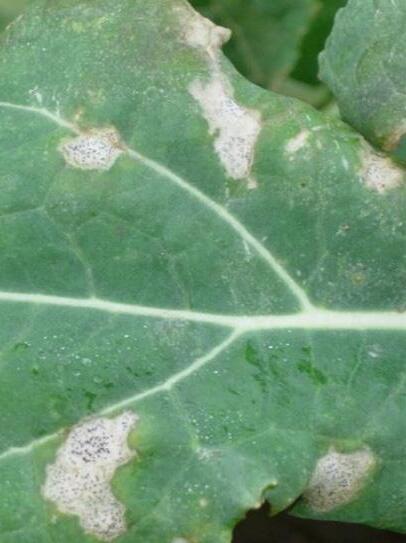

Clayton Augusta™ Fungicide OILSEED RAPE
Problem diseases to watch out for in the autumn...

Phoma spray threshold: 10-20% plants infected (use lower threshold on more susceptible varieties and/ or where plants are small).
Image source ADAS
Light leaf spot should be prevented from developing early.
Good protection from subsequent disease development will be provided by a protective application of prothioconazole or tebuconazole in autumn/winter after GS20 (usually late October to early December).
Follow up spray(s) with an alternative product may be required in the spring from stem elongation, depending on disease development.
Phoma leaf spot/Stem canker can be found from October onwards and best control of stem canker may be expected from an autumn application (after GS 20) of prothioconazole or tebuconazole based products applied at the first sign of disease.
A repeat application of an alternative effective product in late autumn/winter may be required if symptoms reoccur.
For the best start, closely monitor crops for Phoma and Light leaf spot spray thresholds* in the autumn period and treat with broadspectrum protective and systemic fungicides (with either straight or coformulated product options) where required.
Disease management to control damaging diseases in the autumn is vital:
• Light Leaf Spot can lead to yield losses of up to 1.0 t/ha if left unchecked. Early prevention is key, as infection often begins in autumn but symptoms can be delayed.
• Phoma infection typical causes yield reductions of 0.5t/ha in susceptible varieties. Early leaf spotting is the first warning sign.
AHDB data shows average yield responses to a two-spray autumn fungicide programme at 0.3t/ha.

Light leaf spot threshold: As soon as infection is seen (to confirm disease, incubate leaves).
Image source ADAS
Clayton Augusta™
Broad-spectrum systemic and protectant strobilurin fungicide.
OSR Cereals Fruit Peas Beans Potatoes Field Vegetables
Active Ingredients: 250g/l azoxystrobin
SC Formulation Suspension Concentrate
Use Rate & Timing: Apply at 1.0 L/ha for a maximum of 2 treatments per crop at a minimum 21-day spray interval. Latest application 21 days before harvest. Use against Sclerotinia as a protectant during flowering (best results from an application timing GS60-GS65, from early to midflowering). Use against Alternaria as a protectant at early pod formation (before first spots appear on the pods).
Target Diseases: Spring - Dark Leaf and Pod Spot Alternaria spp. (control). Sclerotinia stem rot (moderate control).
• Ideal tank-mix partner with triazoles for a resistance-smart spring strategy.
• SC formulation with 250g/L azoxystrobin for reliable coverage.
• Strong protectant activity against Sclerotinia stem rot at flowering.
• Useful Alternaria control when applied at early pod formation.

